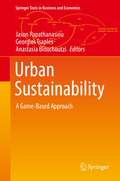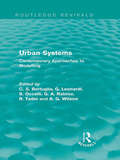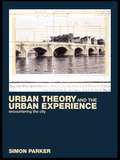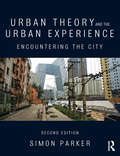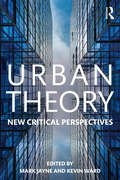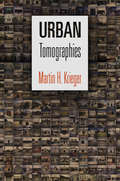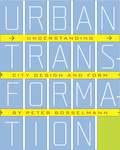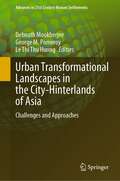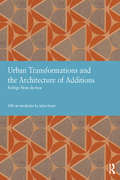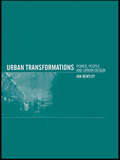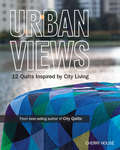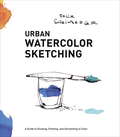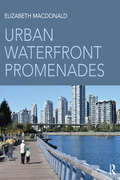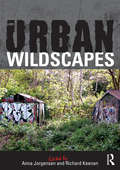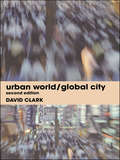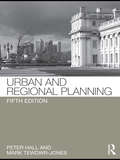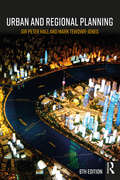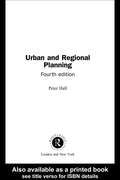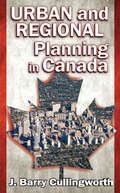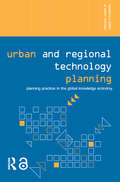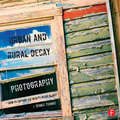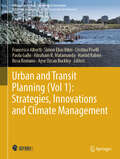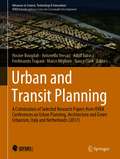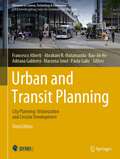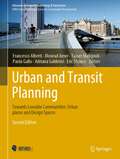- Table View
- List View
Urban Sustainability: A Game-Based Approach (Springer Texts in Business and Economics)
by Jason Papathanasiou Georgios Tsaples Anastasia BlouchoutziThis textbook provides an innovative pedagogy to students who will be the policy makers of tomorrow. It provides thoughts on sustainability and the complexity among its different dimensions. It guides students through experience, processes of complex decision making, and sharpen their clarity of thought, to enhance their communication abilities and help them develop critical thinking. It provides key competencies to address the complexities of sustainable development.By combining game-based learning with an analytical style of education, supplemental materials are provided to make the definitions of various sustainability aspects more concrete and allows students to experiment in a consequence-free environment, with scenario examples. Board Game and a hypothetical management course, dealing with various topics like transportation sustainability, societal metabolism, etc. as well as with decision making under those contexts, will formalize the mathematics needed to make robust decisions.
Urban Systems: Contemporary Approaches to Modelling (Routledge Revivals #Vol. 1)
by C. S. Bertuglia A. G. Wilson G. Leonardi S. Occelli G. A. Rabino R. TadeiThis edited collection, first published in 1987, provides a comparative analysis of different approaches to urban modelling, and lays the foundations for the possibility of integration and a more unified field. The first part contextualises the development of the field of urban systems modelling, focusing on the variety of approaches and possible implications of this on the future of research and methodology. Next, the editors consider economic and ‘non-economic’ approaches, followed by an analysis of spatial-interaction-based approaches. Providing an overview to the field and research literature, the overarching argument is that there should be an integrated methodological approach to urban system modelling.
Urban Theory and the Urban Experience: Encountering the City
by Simon ParkerFor the first time Urban Theory and the Urban Experience brings together classic and contemporary approaches to urban research in order to reveal the intellectual origins of urban studies, and the often unacknowledged debt that empirical and theoretical perspectives on the city owe to one another. Both students and urban scholars will appreciate the critical way in which classical and contemporary debates on the nature of the city are presented. Extensive use is made throughout of documentary, literary and cultural sources to bring the different theoretical perspectives to life. Discussion points introduce and explain key concepts and intellectual histories in a jargon free manner. End of chapter further readings have also been annotated to encourage additional study.
Urban Theory and the Urban Experience: Encountering the City
by Simon ParkerUrban Theory and the Urban Experience brings together classic and contemporary approaches to urban research in order to reveal the intellectual origins of urban studies and the often unacknowledged debt that empirical and theoretical perspectives on the city owe one another. From the foundations of modern urban theory in the work of Weber, Simmel, Benjamin and Lefebbvre to the writings of contemporary urban theorists such as David Harvey and Manuel Castells and the Los Angeles school of urbanism, Urban Theory and the Urban Experience traces the key developments in the idea of the city over more than a century. Individual chapters explore investigative studies of the great metropolis from Charles Booth to the contemporary urban research of William J. Wilson, along with alternative approaches to the industrial city, ranging from the Garden City Movement to ‘the new urbanism’. The volume also considers the impact of new information and communication technologies, and the growing trend towards disaggregated urban networks, all of which raise important questions about viability and physical and social identity of the conventional townscape. Urban Theory and the Urban Experience concludes with a rallying cry for a more holistic and integrated approach to the urban question in theory and in practice if the rich potent. For the benefit of students and tutors, frequent question points encourage exploration of key themes, and annotated further readings provide follow-up sources for the issues raised in each chapter. The book will be of interest to students, scholars, practitioners and all those who wish to learn more about why the urban has become the dominant social, economic and cultural form of the twenty-first century
Urban Theory: New critical perspectives
by Kevin Ward Mark JayneUrban Theory: New Critical Perspectives provides an introduction to innovative critical contributions to the field of urban studies. Chapters offer easily accessible and digestible reviews, and as a reference text Urban Theory is a comprehensive and integrated primer which covers topics necessary for a full understanding of recent theoretical engagements with cities. The introduction outlines the development of urban theory over the past two hundred years and discusses significant theoretical, methodological and empirical challenges facing the field of urban studies in the context of an increasing globally inter-connected world. The chapters explore twenty-four topics, which are new additions to the urban theoretical debate, highlighting their relationship to long established concerns that continue to have intellectual purchase, and which also engage with rich new and emerging avenues for debate. Each chapter considers the genealogy of the topic at hand and also includes case studies which explain key terms or provide empirical examples to guide the reader to a better understanding of how theory adds to our understanding of the complexities of urban life. This book offers a critical and assessable introduction to original and groundbreaking urban theory and will be essential reading for undergraduate and postgraduate students in human geography, sociology, anthropology, cultural studies, economics, planning, political science and urban studies.
Urban Tomographies (The City in the Twenty-First Century)
by Martin H. KriegerTomography is a method of exploring a phenomenon through a large number of examples or perspectives. In medical tomography, such as a CAT scan, two-dimensional slices or images of a three-dimensional organ are used to envision the organ itself. Urban tomography applies the same approach to the study of city life. To appreciate different aspects of a community, from infrastructure to work to worship, urban planning expert Martin H. Krieger scans the myriad sights and sounds of contemporary Los Angeles. He examines these slices of life in Urban Tomographies.The book begins by introducing tomographic methods and the principles behind them, which are taken from phenomenological philosophy. It draws from the examples of Lee Friedlander and Walker Evans, as well as Denis Diderot, Charles Marville, and Eugène Atget, who documented the many facets of Paris life in three crucial periods. Rather than focus on singular, extraordinary figures and events as do most documentarians, Krieger looks instead at the typical, presenting multiple specific images that call attention to people and activities usually rendered invisible by commonality. He took tens of thousands of photographs of industrial sites, markets, electrical distributing stations, and storefront churches throughout Los Angeles. He also recorded the city's ambient sounds, from the calls of a tamale vendor to the buzz of a workshop saw. Krieger considers these samples from the urban sensorium in this innovative volume, resulting in a thoughtful illumination of the interplay of people with and within the built environment. With numerous maps and photographs, as well as Krieger's unique insights, Urban Tomographies provides an unusually representative and rounded view of the city.
Urban Transformation: Understanding City Form and Design
by Peter BosselmannHow do cities transform over time? And why do some cities change for the better while others deteriorate? In articulating new ways of viewing urban areas and how they develop over time, Peter Bosselmann offers a stimulating guidebook for students and professionals engaged in urban design, planning, and architecture. By looking through Bosselmann's eyes (aided by his analysis of numerous color photos and illustrations) readers will learn to "see" cities anew. Bosselmann organizes the book around seven "activities": comparing, observing, transforming, measuring, defining, modeling, and interpreting. He introduces readers to his way of seeing by comparing satellite-produced "maps" of the world's twenty largest cities. With Bosselmann's guidance, we begin to understand the key elements of urban design. Using Copenhagen, Denmark, as an example, he teaches us to observe without prejudice or bias. He demonstrates how cities transform by introducing the idea of "urban morphology" through an examination of more than a century of transformations in downtown Oakland, California. We learn how to measure quality-of-life parameters that are often considered immeasurable, including "vitality," "livability," and "belonging." Utilizing the street grids of San Francisco as examples, Bosselmann explains how to define urban spaces. Modeling, he reveals, is not so much about creating models as it is about bringing others into public, democratic discussions. Finally, we find out how to interpret essential aspects of "life and place" by evaluating aerial images of the San Francisco Bay Area taken in 1962 and those taken forty-three years later. Bosselmann has a unique understanding of cities and how they "work." His hope is that, with the fresh vision he offers, readers will be empowered to offer inventive new solutions to familiar urban problems.
Urban Transformational Landscapes in the City-Hinterlands of Asia: Challenges and Approaches (Advances in 21st Century Human Settlements)
by George M. Pomeroy Debnath Mookherjee Le Thi Thu HuongIn the context of mounting challenges stemming from a rapid transformation of the urban-regional landscapes in many Asian countries, this book highlights a multifaceted array of issues that increasingly engage the academic and planning communities in search of viable solutions to complex problems facing us. Even though cities continue to dominate development studies, urbanization of Asia is evolving toward a hybrid urban-rural nexus beyond the cities. This volume considers these shifting dynamics of Asian urbanization, including urban spatial transformations and their ramifications in the context of sustainability and planning. Through the lens of a set of empirical studies across diverse disciplines, geographies and methodologies. yet with an overarching concern for sustainability in varied (but interconnected) areas such as climate change, land use planning, infrastructure and urban mobility, and quality of life, these studies examine a range of important topics (e.g., flooding, transportation, housing, open space/ green space, urban garden and such) in city/regional settings. Together, they add insights into varied transformational processes or patterns at work on the urban-regional landscapes in a number of Asian countries while offering innovative approaches or alternatives. The proposed volume fills a gap in urban/regional studies in context of South and Southeast Asia that will be of interest to all stakeholders (e.g., planners, administrators, academicians and the citizenry), particularly those interested in sustainability and planning paradigms. It should be a timely and valuable addition to the Asian urbanization literature.
Urban Transformations and the Architecture of Additions (Studies in International Planning History)
by Rodrigo Perez de ArceRodrigo Perez de Arce's essay Urban Transformations and Architectural Additions was published during the formative stages of Post Modernism, at the point where theory was becoming seriously established. Jencks' first essays formalising the term Post Modernism in architecture and the revised Learning from Las Vegas were published the previous year. In planning terms, modernism had become associated with comprehensive redevelopment and forms of urban organisation that ignored context, history and any sense of tradition. De Arce considered the essential nature of buildings and the richness of historic urban form and explored how robust that essence was over time. He looked at the value of essential remnants and rich complexities in maintaining a sense of continuity and relevance. Having explored the adaptation process in history, de Arce went on to see how such a process might be simulated in contemporary cities with modern buildings, using additions and layers to change them from objects in infinite windswept space to being part of a rich urban fabric which described urban place. To do this he used concrete examples; housing schemes by James Stirling, new government centres in Chandigrah and Dacca and more prosaic 60's housing blocks. The paper had a fundamental influence on the way that architects and planners thought about the nature of cities: as dynamic organisms that were tangible to human beings, completely opposite to the systems thinking of the time. It contributed to ideas about the importance of street, place and city block which influenced so much recent regeneration practice. As we enter a phase of development where the reuse and adaptation of existing buildings is becoming paramount from both an economic and sustainable point of view, Perez de Arce's paper gives important insights into how to think about the process positively.
Urban Transformations: Power, People and Urban Design
by Ian BentleyCities affect every person's life, yet across the traditional divides of class, age, gender and political affiliation, armies of people are united in their dislike of the transformations that cities have undergone in recent times. The physical form of the urban environment is not a designer add-on to 'real' social issues; it is a central aspect of the social world. Yet in many people's experience, the cumulative impacts of recent urban development have created widely un-loved urban places. To work towards better-loved urban environments, we need to understand how current problems have arisen and identify practical action to address them.Urban Transformations examines the crucial issues relating to how cities are formed, how people use these urban environments and how cities can be transformed into better places. Exploring the links between the concrete physicality of the built environment and the complex social, economic, political and cultural processes through which the physical urban form is produced and consumed, Ian Bentley proposes a framework of ideas to provoke and develop current debate and new forms of practice.
Urban Views: 12 Quilts Inspired by City Living
by Cherri HouseThe bestselling author of City Quilts is back with &“12 projects in her graphic, modern and colorful style, all created with solid or near-solid fabrics&” (Down Under Quilts Magazine). Cherri House invites you to continue on her quilt making journey in her latest book Urban Views. In this collection of 12 all-new projects, you&’ll learn how to quilt with triangles as well as master a variety of innovative techniques. In the &“City Challenge,&” the author explores 4 more U.S. cities with new quilt designs. All of the projects are rendered in House&’s beloved signature style and will surely inspire sewists of every skill level. Beginner and experienced sewists alike can create modern, must-have quilts with innovative techniquesFeatures modern solid fabric quilt designs with a universal appeal, making them excellent gifts for men and women alike &“House comes down solidly on the side of solids, and with her imaginative designs, the fabrics soar.&”—Publishers Weekly
Urban Watercolor Sketching
by Felix ScheinbergerA guide that shows painters, drawers, doodlers, and urban sketchers how to bring their drawings to life with colorful, bold, yet accessible painting methods.Watercolor sketching is a rapidly emerging technique that enlivens sketches done in pen or pencil with the expressive washes, glazes, and luminous hues of watercolor . This lushly illustrated resource teaches artists on the go how to sketch with watercolor, rendering subjects efficiently and without inhibitions. Readers are guided through all aspects of the medium, from fundamental techniques including wet-on-wet, glazing, and washes; materials and supplies; and little known tips and tricks for getting the most out of watercolor (for example, just sprinkling a little salt on your painting creates a texture that's impossible to achieve with a brush.) A strong focus color theory provides a solid foundation for enhancing drawings with vibrant hues.
Urban Waterfront Promenades
by Elizabeth MacdonaldSome cities have long-treasured waterfront promenades, many cities have recently built ones, and others have plans to create them as opportunities arise. Beyond connecting people with urban water bodies, waterfront promenades offer many social and ecological benefits. They are places for social gathering, for physical activity, for relief from the stresses of urban life, and where the unique transition from water to land eco-systems can be nurtured and celebrated. The best are inclusive places, welcoming and accessible to diverse users. This book explores urban waterfront promenades worldwide. It presents 38 promenade case studies—as varied as Vancouver’s extensive network that has been built over the last century, the classic promenades in Rio de Janeiro, the promenades in Stockholm’s recently built Hammarby Sjöstad eco-district, and the Ma On Shan promenade in the Hong Kong New Territories—analyzing their physical form, social use, the circumstances under which they were built, the public policies that brought them into being, and the threats from sea level rise and the responses that have been made. Based on wide research, Urban Waterfront Promenades examines the possibilities for these public spaces and offers design and planning approaches useful for professionals, community decision-makers, and scholars. Extensive plans, cross sections, and photographs permit visual comparison.
Urban Wildscapes
by Anna Jorgensen Richard KeenanUrban Wildscapes is one of the first edited collections of writings about urban ‘wilderness’ landscapes. Evolved, rather than designed or planned, these derelict, abandoned and marginal spaces are frequently overgrown with vegetation and host to a wide range of human activities. They include former industrial sites, landfill, allotments, cemeteries, woods, infrastructural corridors, vacant lots and a whole array of urban wastelands at a variety of different scales. Frequently maligned in the media, these landscapes have recently been re-evaluated and this collection assembles these fresh perspectives in one volume. Combining theory with illustrated examples and case studies, the book demonstrates that urban wildscapes have far greater significance, meaning and utility than is commonly thought, and that an appreciation of their particular qualities can inform a far more sustainable approach to the planning, design and management of the wider urban landscape. The wildscapes under investigation in this book are found in diverse locations throughout the UK, Europe, China and the US. They vary in scale from small sites to entire cities or regions, and from discrete locations to the imaginary wildscapes of children’s literature. Many different themes are addressed including the natural history of wildscapes, their significance as a location for all kinds of playful activity, the wildscape as ‘commons’ and the implications for landscape architectural practice, ranging from planting interventions in wildscapes to the design of the urban public realm on wildscape principles.
Urban World/Global City
by David ClarkThis book identifies and accounts for the characteristics of the contemporary city and of urban society. It analyzes the distribution and growth of settlements and explores the social and behavioral characteristics of urban living. The latest theoretical and empirical developments and insights are synthesized and presented in an accessible and engaging way.This second edition has been extensively updated and referenced. Each chapter includes sets of learning objectives, annotated readings and topics for discussion. Well-illustrated throughout, it will be essential reading for students of geography, sociology and development studies and all who seek an understanding of how the urban world has evolved and how it will change in the twenty-first century.
Urban and Regional Planning
by Peter Hall Mark Tewdwr-JonesThis is the fifth edition of the classic text for students of urban and regional planning. It gives an historical overview of the developments and changes in the theory and practice of planning, throughout the entire twentieth century. This extensively revised edition follows the successful format of previous editions: it introduces the establishment of planning as part of the public health reforms of the late nineteenth century and goes on to look at the insights of the great figures who influenced the early planning movement, leading up to the creation of the post-war planning machine national and regional planning, and planning for cities and city regions, in the UK, from 1945 to 2010, is then considered. Specific reference is made to the most important British developments in recent times, including the Single Regeneration Budget, English Partnerships, the devolution of Scotland, Wales and Northern Ireland, the establishment of the Mayor of London and the dominant urban sustainability paradigm planning in Western Europe, since 1945, now incorporating new material on EU-wide issues, as well as updated country specific sections planning in the United States, since 1945, now discussing the continuing trends of urban dispersal and social polarisation, as well as initiatives in land use planning and transportation policies finally the book looks at the nature of the planning process at the start of the twenty-first century, reflecting briefly on shifts in planning paradigms since the 1960s and going on to discuss the main issues of the 1990s and 2000s, including sustainability and social exclusion and looking forward to the twenty-first century.
Urban and Regional Planning
by Peter Hall Mark Tewdwr-JonesThis is the sixth edition of the classic text for students of urban and regional planning. It gives a historical overview of the developments and changes in the theory and practice of planning throughout the entire 20th and first part of the 21st centuries. The extensively revised edition incorporates the most important developments in recent times: debates on economic rebalancing and national infrastructure including high speed rail, energy, millennium projects, Celtic devolution, European influence, impact of London on nation. A new chapter "Planning for cities and city regions 1990-2017": includes new material on housing, localism, neighbourhood planning, privatisation, city modernism, reform, Devo and city deals and metro mayors. Urban and Regional Planning will be invaluable to undergraduate as well as postgraduate Planning students. It will prove useful in a variety of built environment areas such as Architecture, Landscape Architecture, Urban Design, Real Estate where planning is taught.
Urban and Regional Planning
by Peter HallThis is the fourth edition of the classic text for students of urban and regional planning. It gives a historical overview of the developments and changes in the theory and practice of planning, throughout the entiretwentieth century.This extensively revised edition follows the successful format of previous editions. Specific reference is made to the most important British developments in recent times, including the devolution of Scotland, Wales and Northern Ireland, the establishment of the Mayor of London and the dominant urban sustainability paradigm.Planning in Western Europe, since 1945, now incorporates new material on EU-wide issues as well as updated country specific sections. Planning in the United States since 1945, now discusses the continuing trends of urban dispersal and social polarisation, as well as initiatives in land use planning and transportation policies.The book looks at the nature of the planning process at the end of the twentieth century and looks forward to the twenty-first century.
Urban and Regional Planning in Canada
by J. Barry CullingworthOriginally published in 1987, this book presents a wide-ranging review of urban, regional, economic, and environmental planning in Canada. A comprehensive source of information on Canadian planning policies, it addresses the wide variations between Canadian provinces. While acknowledging similarities with programs and policies in the United States and Britain, the author documents the distinctively Canadian character of planning in Canada.Among the topics addressed in the book are: the agencies of planning; on the nature of urban plans; the instruments of planning; land policies; natural resources; regional planning at the federal level; regional planning and development in Ontario; regional planning in other provinces; environmental protection; planning and people; and reflections on the nature of planning in Canada.The author documents how governmental agencies handle problems of population growth, urban development, exploitation of natural resources, regional disparities, and many other issues that fall within the scope of urban and regional planning. But he goes beyond this to address matters of politics, law, economics, social organization. The book is pragmatic, eclectic, interpretive, and critical. It is a valuable contribution to international literature on planning in its political context.
Urban and Regional Technology Planning: Planning Practice in the Global Knowledge Economy (Networked Cities Series)
by Mark Wilson Kenneth E. CoreyPart of the popular Networked Cities series, Urban and Regional Technology Planning focuses on the practice of relational planning and the stimulation of local city-regional scale development planning in the context of the global knowledge economy and network society. Designed to offer scholars, practitioners, and decision makers studies on the ways of cities, technologies, and multiple forms of urban movement intersect and create the contemporary urban environment, Kenneth Corey and Mark Wilson explore the dynamics of technology-induced change that is taking place within the context of the global knowledge economy and network society. Examining first the knowledge economy itself, Wilson and Corey go on to discuss its implications before proposing ways to strategize for future intelligent development, with particular emphasis on the ALERT model for regional and local planning. An important read for those practicing or studying planning in this network society.
Urban and Rural Decay Photography: How to Capture the Beauty in the Blight
by J. Dennis ThomasIf you are a photographer who sees the beauty in abandoned buildings, crumbling facades, and preserving a fading history, and who also has a love of urban exploration, you have stumbled on a must-have for your photographic library. Urban and Rural Decay Photography offers expert tips and techniques for capturing breathtaking photographs of your favorite decay scenes, whether in urban or rural settings. Author J. Dennis Thomas guides you through the history of decay photography, shows you what equipment you will need, and discusses digital, film and HDR capture and composition. The book addresses which artistic considerations work best for the kinds of shots that capture a moment and convey a story. He also provides you with important safety advice and matters of the law when entering and working with decaying structures. Chock full of inspiring images that will ignite your creativity and your passion for decay photography, Urban and Rural Decay Photography is just the book you need to get you out and discovering your newest urban or rural exploration adventure.
Urban and Transit Planning (Advances in Science, Technology & Innovation)
by Simon Elias Bibri Francesco Alberti Abraham R. Matamanda Paola Gallo Cristina Piselli Hamid Rabiei Rosa Romano Ayse Ozcan BuckleyThis book explores aspects of creating cities and structures with a focus on sustainability. It provides an analysis of contemporary methodologies, technologies, and principles essential for designing urban environments and buildings that significantly reduce environmental impact. Moreover, it emphasizes the importance of energy efficiency, resource conservation, and the integration of green spaces to enhance the quality of life for urban dwellers. Covering a broad spectrum of topics, from sustainable urban mobility to green architecture and smart city initiatives, this book serves as an invaluable resource for professionals, researchers, and students. Furthermore, it aims to inspire and guide those dedicated to developing a sustainable future through innovative and responsible urban planning and architectural design practices.
Urban and Transit Planning: A Culmination of Selected Research Papers from IEREK Conferences on Urban Planning, Architecture and Green Urbanism, Italy and Netherlands (2017) (Advances in Science, Technology & Innovation)
by Nancy Clark Hocine Bougdah Antonella Versaci Adolf Sotoca Ferdinando Trapani Marco MiglioreA volume of five parts, this book is a culmination of selected research papers from the second version of the international conferences on Urban Planning & Architectural Design for sustainable Development (UPADSD) and Urban Transit and Sustainable Networks (UTSN) of 2017 in Palermo and the first of the Resilient and Responsible Architecture and Urbanism Conference (RRAU) of 2018 in the Netherlands. This book, not only discusses environmental challenges of the world today, but also informs the reader of the new technologies, tools, and approaches used today for successful planning and development as well as new and upcoming ones. Chapters of this book provide in-depth debates on fields of environmental planning and management, transportation planning, renewable energy generation and sustainable urban land use. It addresses long-term issues as well as short-term issues of land use and transportation in different parts of the world in hopes of improving the quality of life. Topics within this book include: (1) Sustainability and the Built Environment (2) Urban and Environmental Planning (3) Sustainable Urban Land Use and Transportation (4) Energy Efficient Urban Areas & Renewable Energy Generation (5) Quality of Life & Environmental Management Systems. This book is a useful source for academics, researchers and practitioners seeking pioneering research in the field.
Urban and Transit Planning: City Planning: Urbanization and Circular Development (Advances in Science, Technology & Innovation)
by Francesco Alberti Abraham R. Matamanda Paola Gallo Adriana Galderisi Bao-Jie He Marzena SmolThis book represents a compilation of research in sustainable architecture and planning. Its main focus is offering strategies and solutions that help reducing of the negative impacts of buildings on the environment and emphasizing the suitable management of available resources. By tackling the topic of sustainability from a historical perspective and also as a vision for the future, the book in hands provides new horizons for engineers, urban planners and environmentalists interested in the optimization of resources, space development, and the ecosystem as a whole to address the complex unresolved problems our cities are facing. This book is a culmination of selected research papers from IEREK’s sixth edition of the International Conference on Urban Planning & Architectural Design for Sustainable Development (UPADSD) held online in collaboration with the University of Florence, Italy (2021) and the first edition of the International Conference on Circular Economy for Sustainable Development (CESD) held online in collaboration with the University of Salento, Lecce, Italy (2021).
Urban and Transit Planning: Towards Liveable Communities: Urban places and Design Spaces (Advances in Science, Technology & Innovation)
by Eric Strauss Yasser Mahgoub Francesco Alberti Paola Gallo Mourad Amer Adriana GalderisiThis book incorporates a wealth of research focused on the more and more urgent challenges that urban planning and architectural design all over the world must cope with: from climate change to environmental decay, from an increasing urban population to an increasing poverty. In detail, this book aims at providing innovative approaches, tool and case study examples that, in line with the agenda of 2030, may better drive human settlements toward a sustainable, inclusive and resilient development. To this aim, the book includes heterogeneous regional perspectives and different methodologies and suggests development models capable of limiting further urban growth and re-shaping existing cities to improve both environmental quality and the overall quality of life of people, also taking account the more and more close relationships among urban planning and technological innovation.
